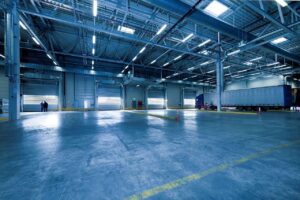Completing a retrofit provides an opportunity to improve your building’s energy efficiency and reduce its operational costs. But knowing where to start can be challenging! Follow our tips below to make retrofitting your warehouse or factory as easy as possible.
Step #1: Complete Benchmarking
Before beginning, you need to know where your facility currently stands in order to know where improvements can be made. Benchmarking results provide a great opportunity to compare your building’s energy usage against comparable buildings.
Use an energy benchmarking system to determine your building’s current Energy Star rating. Factors such as climate, hours of operation and occupancy can be normalized in this process, allowing your building to be compared fairly and consistently to similar facilities.
Step #2: Develop a Plan of Action
Once your building’s Energy Use Intensity (EUI) or Energy Star score has been calculated, you are ready to form a retrofit plan.
After establishing a baseline for your warehouse or factory, complete an energy audit and building commissioning assessment to help prioritize efficiency upgrades.
The efficiency upgrade activities can then be prioritized that will yield your facility the biggest returns.
Step #3: Implement Major Retrofits
A staged approach is recommended to improve facility performance.
Because lighting plays a large role in other building systems including heating and cooling and power quality, it comes first. Now’s the time to install new light sources, fixtures and controls.
Focus next on secondary load sources, including electronic equipment and the building itself. These energy consumption contributors can affect heating, cooling and electric loads. Analyzing these sources and their relationship with your HVAC systems can determine how to reduce equipment size and upgrade costs.
Air distribution systems include air for ventilating and heating or cooling into the building and can affect both energy consumption and occupant comfort. Fan systems can also be adjusted to deliver air using maximum energy efficiency.
By this point, cooling and heating loads are likely to be reduced in the previous stages. That, combined with the fact that many HVAC systems are oversized to start with, means that a smaller system could potentially be installed.
The Value in an Energy Audit
Although completing a retrofit can initially seem inconvenient, it will pay off in the end – big time. Major retrofits can bring savings of 15 to 40 percent to a company, plus a slew of other benefits including:
- Lower energy bills and cost-savings that can be re-invested into your business
- A property value increase and higher occupancy rates
- A reduction in operating and maintenance expenses
- Less environmental impact
If you need help determining what type of retrofits your warehouse or factory could benefit from, a professional energy audit can help.
At Daisy Energy, we have been helping businesses throughout Southern Ontario lower their carbon footprint by providing them with energy efficient lighting, renewable energy systems and energy sub-metering. Let us help you lower your energy costs, too! Contact us today for more information about our services.




































